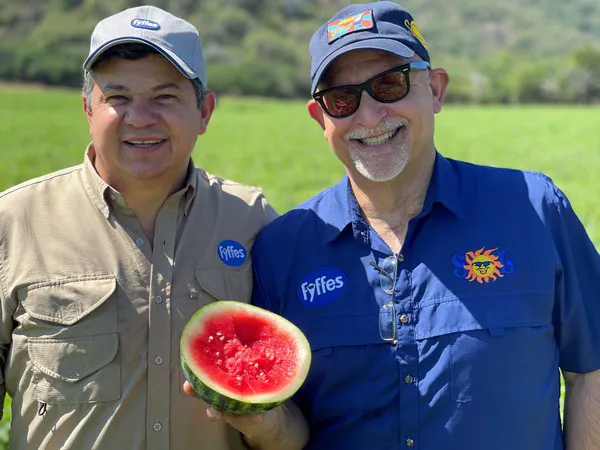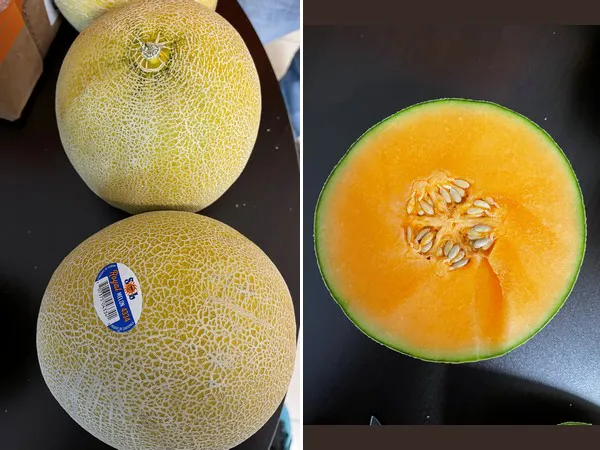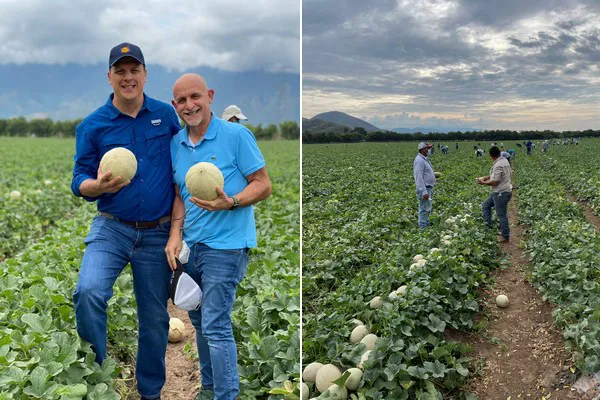The US offshore season for melons kicked off early November. “We started with bringing in melons from the Zacapa Valley in Guatemala,” says Mark Cassius, President of Sol Group Marketing, a division of Fyffes. The Zacapa Valley is one of the main melon production regions in Guatemala. It’s a desert region that could be compared to California’s Central Valley. In January, production shifted to the Choluteca region in Honduras and then back to Guatemala in February to finish the second cycle. “Right now, we are in peak production until the end of April,” Cassius said. The offshore season typically finishes during the first half of May, before the domestic season starts.
 Genivaldo Pereira (Managing Director of Melon supply Central America) and Mark Cassius, inspecting Mini Watermelon quality.
Genivaldo Pereira (Managing Director of Melon supply Central America) and Mark Cassius, inspecting Mini Watermelon quality.
Vertically integrated
“Our expertise lies in Central America, that’s our core business,” said Cassius. “We own the farms, control harvest and quality, have our own labs, test quality on a daily basis, and have our own packing houses. Whatever we grow, we sell and whatever we sell, we grow.” Melons are brought into four areas in North America: Florida, the Northeast (Philadelphia), the South (Houston), and the West Coast. “We charter two vessels that sail between Central America and South Florida/Philadelphia on a rotating schedule, only carrying our melons.”
In Houston and Southern California, the company works with 3rd party shipping companies. Having coverage in these four regions allows Sol Group to bring in melons close to end users across the North American continent, including the US and Canada. As soon as the offshore season wraps up, Sol Group Marketing steps back and starts preparing for the next fall/winter season. “We put all our energy in the offshore melon season, that’s our core competency.”
 Sol Group's/Fyffes' own vessel being discharged at Port Everglades, FL.
Sol Group's/Fyffes' own vessel being discharged at Port Everglades, FL.
It’s Sol Group’s goal to deliver a good eating experience for everybody. “We always trial a lot of different varieties to make sure there’s a melon for all consumers taste preferences. Currently, we are working on a few proprietary varieties with our breeding partners.” Sol Group Marketing brings in cantaloupes, honeydews, personal watermelons, and big seedless watermelons. "The Caribbean Gold cantaloupe is our main variety and one of the best varieties in winter,” shared Cassius. The Golden cantaloupe is a new variety that is available in limited quantities. It will complement the Caribbean Gold, but it has a more golden color/exterior. It also has a sweeter flavor with a juicier interior.
 Golden Cantaloupe.
Golden Cantaloupe.
Easter celebrations
Consumer research shows that melons are an impulse buy. “As a result, displays are key. It’s important they look clean and appealing as the price of the product is of secondary importance.” Research also suggests melons are for celebrations. “Easter is a great holiday for melons as it’s springtime and the weather is getting warmer, which increases the number of picnics and barbecues.” In addition to whole melons, fresh-cut is also a very important part of overall sales. “It is a growing category and many of our retail partners offer fresh-cut melons as a signature item.”
 Mannuel Inestroza, Fyffes' Human Resources manager in Central America and Mark Cassius during a recent visit in Zacapa Valley.
Mannuel Inestroza, Fyffes' Human Resources manager in Central America and Mark Cassius during a recent visit in Zacapa Valley.
 For more information:
For more information:
Mark Cassius
Sol Group Marketing
Tel: (+1) 954-586-8831
[email protected]
www.solmelons.com
